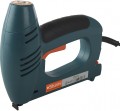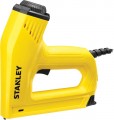Power consumption
The total power consumed by a mains-powered electric tool (see "Power Source"). It is considered the main criterion for assessing the overall capabilities of a particular model: more power leads to better performance. In addition, data on power consumption also allows you to estimate the load on the power grid or other power source; in some cases this is unnecessary.
Performance
The maximum output of a nailer/stapler is the maximum number of strokes it can produce in a minute. Note that in this case, the theoretical maximum is usually indicated — the highest speed of operation achievable under perfect conditions, in fact — the rate of operation of automation, which in many models exceeds 120 beats / min. In fact, this speed is difficult to achieve, because. the performance of the stapler is noticeably limited by the skills of the operator and the features of the functionality: for example, a tool with contact actuation (see below) must be pressed every time, which reduces the speed of work. However,
high performance clearly indicates good reliability and suitability for large volumes of work.
Max. staple length
The largest length of staples (see Fastener Type) that the stapler can work with.
The length in this case means the length of the leg — in other words, the depth to which the staple clogged "to the stop" penetrates into the material. This means that working with staples of great length requires not only the appropriate design of the magazine and the feed mechanism — the stapler must also be quite powerful in order to provide the effort necessary for effective clogging. And this, in turn, affects the dimensions, weight and price of the tool. In fact, this means that it does not always make sense to specifically look for a model that can work with long staples — you need to evaluate the specifics of the intended work: often the best choice is a relatively “short”, but at the same time inexpensive and compact tool.
In general, a limit of 10 – 15 mm is typical for entry-level staplers, and in professional models this parameter can exceed 50 mm.
Min. nail length
The shortest length of nails (see Fastener Type) that the stapler can handle.
The shorter the fastener, with the same thickness, the less effort is required to drive it, but a nail that is too short simply cannot stand under impact normally. Therefore, for many instruments, this restriction is directly indicated. It is worth paying attention to it first of all if you plan to work with small short nails.
Max. nail length
The longest length of nails (see Fastener Type) that the stapler can handle.
With the same thickness, a longer nail requires not only the appropriate space in the magazine and feed mechanism, but also a higher impact energy — otherwise it simply will not work to hammer it “on the head”. This means that the maximum fastener length is directly related to the power and, accordingly, the overall level of the tool. Recall that a powerful professional tool has the appropriate dimensions and weight, moreover, it is often made pneumatic (for more details, see "Type"). Therefore, it makes sense to look for models that are compatible with long nails only if this is critical for the planned work.
Functions
—
Adjustment of impact force / depth. The ability to adjust the force of impact or the depth of clogging fasteners. These functions are implemented somewhat differently: the impact force is changed by adjusting the power supplied to the striker upon impact, and the driving depth can be set due to a mechanical limiter — for example, by retracting the striker a certain distance back, so that it simply does not was able to move beyond a certain distance. However, the purpose and use of these functions is similar: first of all, they allow you to change the depth to which the fastener is driven into the material. In addition, adjusting the force of impact (namely force) can be useful when working with delicate materials, where too powerful impacts are undesirable. Specific details of the implementation of this function should be clarified in each case separately.
—
Double hit. Possibility of operation of the stapler in the double impact mode. Here, this term means the ability to drive two fasteners at once in one blow — for example, for connections that require increased reliability. Note that double impact most often only works on staples, even if the tool is able to work with other types of fasteners (see above). Firstly, it is for brackets that this possibility is most relevant; secondly, it is much more difficult to implement it for nails or pins.
—
Bending the staple.... The ability of the stapler to work not only for driving staples, but also for bending their legs after installation. The need for bending arises in cases where the tool is used to fasten relatively thin layers of material, and the staples pierce the parts to be fastened through: bent legs provide a secure hold, and are also safer — the risk of scratching or pricking the protruding edge of the staple is minimal. Note that such work requires an anvil of hard material placed under the fastened materials; in some tools with a bending function, the anvil is part of the design, but most often it is not.
— Blade of knife. The presence of a knife blade in the design of the stapler. This feature allows you to use the tool not only for driving fasteners, but also for cutting material — for example, preparing upholstery for furniture. The blades are usually made removable (so that a dull one can be quickly replaced with a fresh one or sharpened with convenience) and have a beveled shape (this allows you to cut with the very tip of the knife, providing high accuracy and accuracy). However, this function is quite specific, therefore it is rare, and mainly among percussion models (see "Type") — only they turn out to be quite light, compact and convenient for use as knives.
— Backlight. The presence in the stapler of its own built-in flashlight, usually directed in such a way as to highlight the place of impact. This feature is extremely useful when working in low light conditions. Note that such conditions can easily arise even under normal ambient lighting: for example, the tool itself often obscures the impact site, worsening visibility and complicating accurate aiming.
— Brushless motor. Such motors do not have the classic carbon brushes found in conventional power tools, whose friction during engine operation leads to additional heating, which leads to unnecessary energy consumption and general engine wear. Refusal to use them allows you to extend the battery life of the tool, on the one hand, as well as the life of the engine, on the other.
